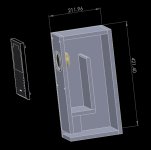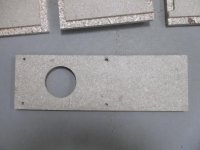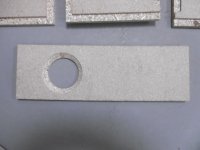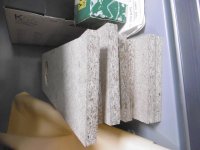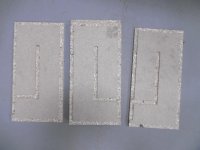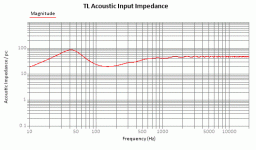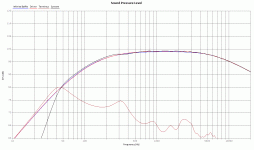OK, I'm going to do it...
I am going to build a TABAQ with the FaitalPro 3FE22. I know others have done this, but I figured I'd make a build thread in case anyone is interested.
Some people advised me not to take apart the boxes I had built for these drivers, see TL design with Tangband W-5-2143, but I can easily remove the drivers without destroying the boxes, so no harm done.
Bjorn has kindly provided a sim for a slightly modified version of the TABAQ, and I have done some drawing and made a folded version. One question I have so far is: have I measured the line length correctly? See the attached pdf, I measured along the dotted line, with sharp corners, is this correct?
Any thoughts from anyone on this? I will post more details of my plans soon.
I am going to build a TABAQ with the FaitalPro 3FE22. I know others have done this, but I figured I'd make a build thread in case anyone is interested.
Some people advised me not to take apart the boxes I had built for these drivers, see TL design with Tangband W-5-2143, but I can easily remove the drivers without destroying the boxes, so no harm done.
Bjorn has kindly provided a sim for a slightly modified version of the TABAQ, and I have done some drawing and made a folded version. One question I have so far is: have I measured the line length correctly? See the attached pdf, I measured along the dotted line, with sharp corners, is this correct?
Any thoughts from anyone on this? I will post more details of my plans soon.
Attachments
Last edited:
Sorry, I didn't have time when I first posted to get together the rest of my bits. Here is the sim Bjorn made for the 3FE22, and a more detailed drawing.
The material will be 15 mm particle board that I can get any amount of from pallet cover sheets at work. This stuff seems perfect for speaker cabinets, very dense. Of course, once I get a design I am happy with, I will make the sides out of ply, or glue on a veneer, or find some way the make them look nice, since my goal is to achieve a low cost (less than £100 including the free wood, hopefully) but fairly good sounding set of speakers, possibly with a good amp board built in, that I can replicate for friends who enjoy good sound without filling up their living rooms with massive boxes. As far as I can tell, the 3FE22 is a perfect driver for this, since it's price/performance ratio is very good. Has anyone found a better driver in this range? I haven't ruled out going to a 4 in. full range driver for a little more bass, but using a 5 in. one will just make the cabinet too big, I think.
One thing I didn't put on the drawing is that the width of the cabinet is 145 mm, with 15 mm wood and 5 mm dadoes the inside width is 115 mm. This is purely because I have a pair of front grilles from a set of cheap Sony speakers that I want to put on them, so I matched the width. Will it make much difference what I make the width (obviously it needs to fit the diameter if the driver)? I also am wondering if I measured the line length correctly, maybe with these additional drawings someone will be ably to tell me.
The material will be 15 mm particle board that I can get any amount of from pallet cover sheets at work. This stuff seems perfect for speaker cabinets, very dense. Of course, once I get a design I am happy with, I will make the sides out of ply, or glue on a veneer, or find some way the make them look nice, since my goal is to achieve a low cost (less than £100 including the free wood, hopefully) but fairly good sounding set of speakers, possibly with a good amp board built in, that I can replicate for friends who enjoy good sound without filling up their living rooms with massive boxes. As far as I can tell, the 3FE22 is a perfect driver for this, since it's price/performance ratio is very good. Has anyone found a better driver in this range? I haven't ruled out going to a 4 in. full range driver for a little more bass, but using a 5 in. one will just make the cabinet too big, I think.
One thing I didn't put on the drawing is that the width of the cabinet is 145 mm, with 15 mm wood and 5 mm dadoes the inside width is 115 mm. This is purely because I have a pair of front grilles from a set of cheap Sony speakers that I want to put on them, so I matched the width. Will it make much difference what I make the width (obviously it needs to fit the diameter if the driver)? I also am wondering if I measured the line length correctly, maybe with these additional drawings someone will be ably to tell me.
Attachments
Hi,
Like you, I am a big fan of the 3fe22. Have built some speakers with it. It is a small driver, with small excursion. I have some thoughts on improvement but they are all electronic.
1) you will need a baffle step filter. Better if you could incorporate at the preamp stage. One of the short comings in FR design is there is no electronic compensation of sorts unlike multiway design who incorporate it into their crossover.
2) introduce a high pass filter at about 60Hz at preamp stage. The sound is already about -10 db by then, so any additional bass only moves the cone a lot but no sound.
This will increase your power handling and naturalness of your speaker.
Oon
Like you, I am a big fan of the 3fe22. Have built some speakers with it. It is a small driver, with small excursion. I have some thoughts on improvement but they are all electronic.
1) you will need a baffle step filter. Better if you could incorporate at the preamp stage. One of the short comings in FR design is there is no electronic compensation of sorts unlike multiway design who incorporate it into their crossover.
2) introduce a high pass filter at about 60Hz at preamp stage. The sound is already about -10 db by then, so any additional bass only moves the cone a lot but no sound.
This will increase your power handling and naturalness of your speaker.
Oon
Some pics of the parts, since I had them near a camera .
.
Thanks to Oon for the advice. Just like other times when posting here, it forced me to go away and try to understand a new concept, I am lazy, and I was hoping to get by without having to figure out what baffle step correction was. I found Martin King's work on the subject, and various calculators, but I have a few questions:
-Martin says you need a 6dB correction for free air, but I will always have my speakers against the wall , due to practical considerations and the wife's tastes in home decor. So as far as I understand, I will need less correction. How much do I need, 2,3,4dB?
-I can put both filters in the preamp tap off on my amp, but I am trying to make a set of speakers that are self contained, and can be run off anything, so it would be better if I could put them in the speaker. What do I have to consider when speccing the components? I guess I need a big power resistor, or what? And what do I look for in the coil? Can I wind it myself?
I have more questions about the high pass filter, but got to run now...
Thanks to Oon for the advice. Just like other times when posting here, it forced me to go away and try to understand a new concept, I am lazy, and I was hoping to get by without having to figure out what baffle step correction was. I found Martin King's work on the subject, and various calculators, but I have a few questions:
-Martin says you need a 6dB correction for free air, but I will always have my speakers against the wall , due to practical considerations and the wife's tastes in home decor. So as far as I understand, I will need less correction. How much do I need, 2,3,4dB?
-I can put both filters in the preamp tap off on my amp, but I am trying to make a set of speakers that are self contained, and can be run off anything, so it would be better if I could put them in the speaker. What do I have to consider when speccing the components? I guess I need a big power resistor, or what? And what do I look for in the coil? Can I wind it myself?
I have more questions about the high pass filter, but got to run now...
Attachments
Well if you are backed against the wall, then you will need less, that is the generic rule. However the 3fe22 as well as most full range tend to have a rising response, so it helps to compensate for that too...
The baffle step compensation in theory sounds easy enough, but in practice it is much more difficult because you can't get the frequency and magnitude right unless you measure.
So in practice, this is what it boils down to. The 6db and rising response tend to result in the sound being a bit thin. Adding a baffle step will add more body and the sound will be warmer. Adjust it to taste....
Oon
The baffle step compensation in theory sounds easy enough, but in practice it is much more difficult because you can't get the frequency and magnitude right unless you measure.
So in practice, this is what it boils down to. The 6db and rising response tend to result in the sound being a bit thin. Adding a baffle step will add more body and the sound will be warmer. Adjust it to taste....
Oon
Very interesting, and slightly diverging recommendations... Not sure what to do! I'll probably start without the BSC, see my second post, the goal is to make a fairly low cost and mass produce-able speaker that is fairly small as well, not necessarily to get the best sound possible. It is likely that most of the people I would make these for will have them against the wall, since they are more music lovers than audiophiles, and space considerations will override sound quality. Also, these will be a big step up from what they have now, cheap Sony or Pioneer hifis. Even hooking these speakers up to the hifis in place of the supplied speakers will make a difference, I imagine. I know this is "heresy", but hopefully you understand my goal, if anyone thinks I'm missing something let me know.
I have gotten around to putting Bjorn's sim in the Leonard Audio software, and I am puzzled by the differences between the graphs from LA and the graphs in the sim. I have attached some screenshots, why does the enclosure seem to peak much lower, below 50Hz, in the LA plot? And why is the response much more curved? I was hoping I could get LA to match what comes out of the MJK worksheets, so I could trust it, since it is so simple to use, but this isn't helping. What am I doing wrong?
Can anyone point me to a good calculator for the high pass filter? I found this one: High Pass Filter Calculator, but it asks for two of three values for resistance, capacitance, and frequency, and I really don't know where to start.
I am also hoping that someone can set my mind at ease about the question I asked in my first post: in my folded design, have I measured the line length correctly? See the drawing that I re-attached to this post.
I have gotten around to putting Bjorn's sim in the Leonard Audio software, and I am puzzled by the differences between the graphs from LA and the graphs in the sim. I have attached some screenshots, why does the enclosure seem to peak much lower, below 50Hz, in the LA plot? And why is the response much more curved? I was hoping I could get LA to match what comes out of the MJK worksheets, so I could trust it, since it is so simple to use, but this isn't helping. What am I doing wrong?
Can anyone point me to a good calculator for the high pass filter? I found this one: High Pass Filter Calculator, but it asks for two of three values for resistance, capacitance, and frequency, and I really don't know where to start.
I am also hoping that someone can set my mind at ease about the question I asked in my first post: in my folded design, have I measured the line length correctly? See the drawing that I re-attached to this post.
Attachments
For an 8ohm TABAQ use 1mH and adjust resistor anywhere from 2ohm to 10ohms to taste. Get several resistors in 2ohm, 4.7ohm, 6.7ohm, 10ohm, 1ohm and use alligator clips to adjust BSC externally until you like the balance of the sound. Then solder it and install internally. The 1mH 20ga aircore works well. In a pinch, a cheap ($2 a bag of 20) 10mm x 8mm ferrite core radial lead inductor rated for 2A will work fine. I have used one for years and can’t really tell difference when switched to $10 air core copper coil.
These are great for experimenting:
20pcs Inductor power inductor 1MH 8*10-in Inductors from Home Improvement on Aliexpress.com | Alibaba Group
As an example, here is me adjusting BSC externally on my W5-2143 XKi until I liked what I heard.
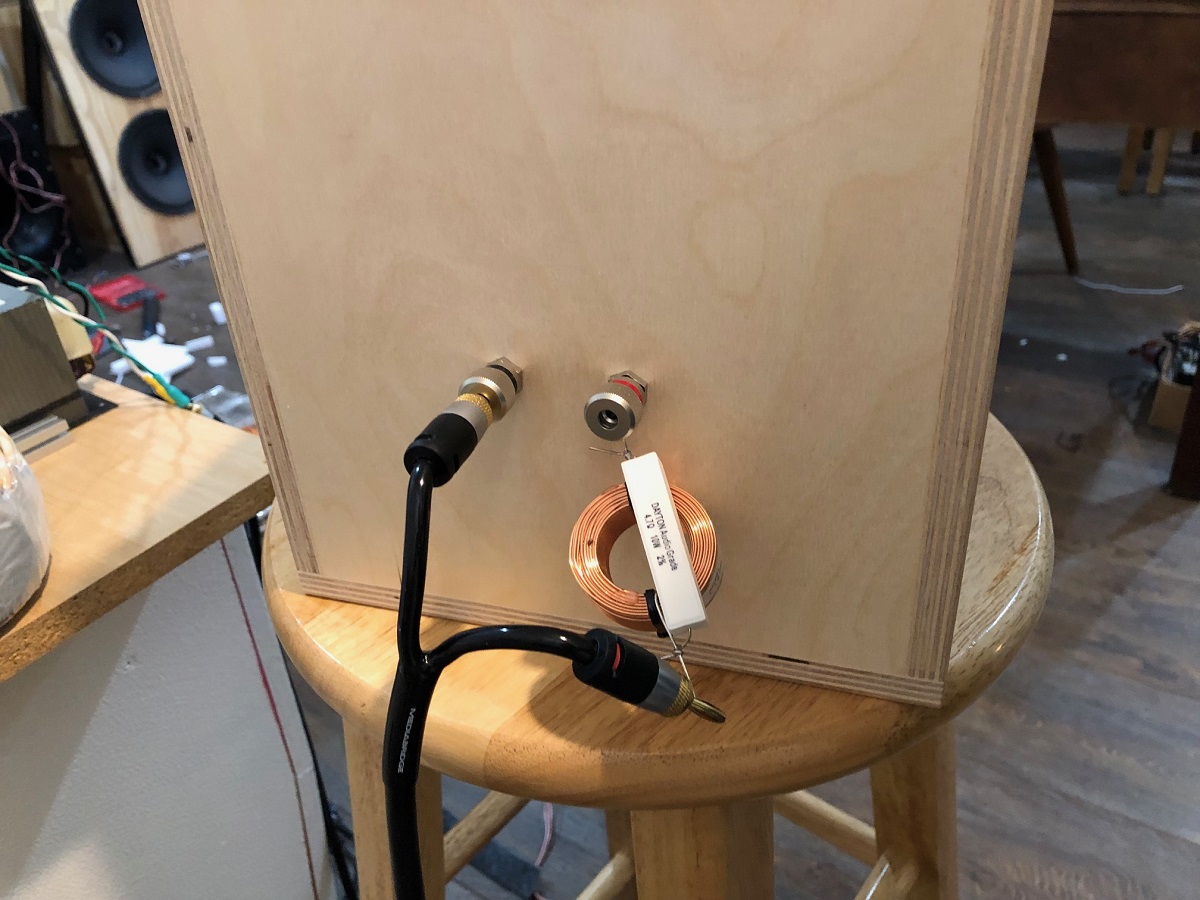
These are great for experimenting:
20pcs Inductor power inductor 1MH 8*10-in Inductors from Home Improvement on Aliexpress.com | Alibaba Group
As an example, here is me adjusting BSC externally on my W5-2143 XKi until I liked what I heard.
Last edited:
Ah I see.. was wondering what TABAQ meant. I thought it is some new transmission line terminology. I have always wanted to try it out properly. I did it once PVC.pipe. the length of the PVC pipe is about a meter. I used a T connection to mount the speaker. At the end, so it faces forward and cap the other end.
After understanding more of the theory. And why the driver shouldn't be on tube end, I realised I should have a pipe at the other side of the tube and cap it. So the driver is somewhere in between... Haven't got around to that part...
Oon
After understanding more of the theory. And why the driver shouldn't be on tube end, I realised I should have a pipe at the other side of the tube and cap it. So the driver is somewhere in between... Haven't got around to that part...
Oon
Good idea!For an 8ohm TABAQ use 1mH and adjust resistor anywhere from 2ohm to 10ohms to taste. Get several resistors in 2ohm, 4.7ohm, 6.7ohm, 10ohm, 1ohm and use alligator clips to adjust BSC externally until you like the balance of the sound. Then solder it and install internally. The 1mH 20ga aircore works well. In a pinch, a cheap ($2 a bag of 20) 10mm x 8mm ferrite core radial lead inductor rated for 2A will work fine. I have used one for years and can’t really tell difference when switched to $10 air core copper coil.
These are great for experimenting:
20pcs Inductor power inductor 1MH 8*10-in Inductors from Home Improvement on Aliexpress.com | Alibaba Group
As an example, here is me adjusting BSC externally on my W5-2143 XKi until I liked what I heard.

Ah I see.. was wondering what TABAQ meant. I thought it is some new transmission line terminology. I have always wanted to try it out properly. I did it once PVC.pipe. the length of the PVC pipe is about a meter. I used a T connection to mount the speaker. At the end, so it faces forward and cap the other end.
After understanding more of the theory. And why the driver shouldn't be on tube end, I realised I should have a pipe at the other side of the tube and cap it. So the driver is somewhere in between... Haven't got around to that part...
Oon
To be frank I gave up trying that way with the 3fe22, even though I love it is because I realise it will never give me the bass I want. 3inch with 1mm of Xmax not going to get you much. So right now it is just used with subwoofer as a WAW/FAST system.
I would go down the 4" route if I were in your shoes. A lot more xmax and lower Fs. Sacrifice on the mids and treble of course. If you asked me for any recommendations, I would say the SBacoustics 12 PAC. Listed as a midwoofer, it goes past 20kHz. I have used it before as a fullrange and sounds pretty decent. Or maybe the scanspeak 10F (haven't used before but a lot of rave on it). In speaker design, quite often sensitivity and Xmax are the opposite of each other. Unless you are trying to use tubes, I would go down that route...
Oon
BTW, my post above is what I would do if I were building speakers for my friend. I would go for a more balanced sound (more bass). The 12PAC has a 5mm Xmax I could imagine what it would do in a nice transmission line. Relatively cheap too... Not necessarily what you should do. I think you should finish the project and tell us how it sounds.
Oh and there is of course 4Fe32. Not as refined in sound, but certainly a lot more bass. Also there are the markaudio stuff.
Oon
Oh and there is of course 4Fe32. Not as refined in sound, but certainly a lot more bass. Also there are the markaudio stuff.
Oon
Have you all looked at this driver?
https://www.parts-express.com/pedocs/specs/295-378-dayton-audio-rs100-4-spec-sheet-revised.pdf
Seems to have a smoother response than the Faital 4FE35s and a lower Fs of 85 Hz (versus 100). It is also less expensive, and although classed as a 4" driver it seems to be more of a 3". Increased power handling and Xmax should help with the low end that the 3FE22s so desperately need.
https://www.parts-express.com/pedocs/specs/295-378-dayton-audio-rs100-4-spec-sheet-revised.pdf
Seems to have a smoother response than the Faital 4FE35s and a lower Fs of 85 Hz (versus 100). It is also less expensive, and although classed as a 4" driver it seems to be more of a 3". Increased power handling and Xmax should help with the low end that the 3FE22s so desperately need.
- Status
- This old topic is closed. If you want to reopen this topic, contact a moderator using the "Report Post" button.
- Home
- Loudspeakers
- Full Range
- TABAQ with FaitalPro 3FE22
